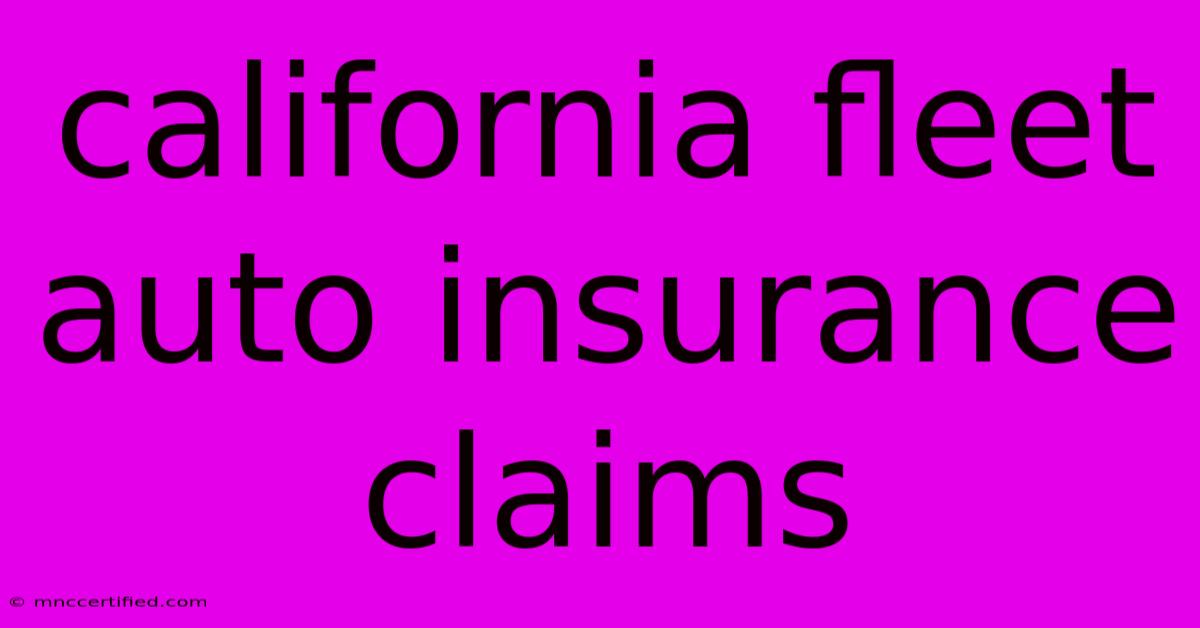California Fleet Auto Insurance Claims

Table of Contents
Navigating California Fleet Auto Insurance Claims: A Comprehensive Guide
Owning and managing a fleet of vehicles in California comes with its own set of unique challenges, and insurance is no exception. Fleet insurance policies differ significantly from standard car insurance, requiring careful consideration and understanding of the claims process. This comprehensive guide will equip you with the knowledge you need to navigate California fleet auto insurance claims smoothly.
Understanding California Fleet Auto Insurance
California fleet insurance policies are specifically designed to cover the risks associated with multiple vehicles operating under a single entity. These policies often offer broader coverage and tailored features catering to the specific needs of fleet owners, including:
- Comprehensive Coverage: Protection against damages from non-collision events like theft, vandalism, fire, and natural disasters.
- Collision Coverage: Covers repairs or replacement costs for vehicles involved in accidents.
- Liability Coverage: Protects the fleet owner from financial responsibility in case of accidents resulting in injuries or property damage to third parties.
- Uninsured/Underinsured Motorist Coverage: Provides financial protection if you're involved in an accident with a driver who doesn't have adequate insurance.
- Rental Reimbursement: Helps cover the cost of renting a replacement vehicle while your insured vehicle is being repaired.
- Towing and Labor Costs: Covers expenses related to towing and roadside assistance for insured vehicles.
- Loss of Use Coverage: Compensates for lost income if your vehicle is inoperable due to an accident.
Filing a Claim: Step-by-Step Process
Here's a step-by-step guide to filing a claim with your California fleet auto insurance provider:
- Report the Incident: Immediately contact your insurance provider and report the incident. Be prepared to provide details about the accident, including the date, time, location, and any involved parties.
- Gather Documentation: Collect essential documents, including police reports, witness statements, photos of the damage, and repair estimates.
- File the Claim: Submit your claim using your insurer's online portal, mobile app, or by contacting their customer service line. Follow their specific instructions and provide all requested information.
- Cooperate with the Insurer: Be responsive to your insurance provider's requests for additional information or documentation.
- Negotiate the Settlement: Review the settlement offer carefully and negotiate a fair price for repairs or replacement costs. Be prepared to provide supporting documentation to justify your request.
Key Tips for Smooth Claims Handling:
- Know Your Policy: Thoroughly understand your policy's coverage limits, deductibles, and exclusions.
- Maintain Accurate Records: Keep detailed records of vehicle maintenance, repairs, and accident history.
- Promptly Report Claims: Do not delay reporting incidents. Prompt action ensures smooth claim processing.
- Communicate Effectively: Keep open communication with your insurance provider throughout the claims process.
- Seek Legal Counsel: If you face difficulties with your insurer, consult an attorney specializing in insurance claims.
Finding the Right Fleet Insurance Provider
Choosing the right insurance provider for your California fleet is crucial. Consider these factors:
- Coverage Options: Ensure the provider offers comprehensive coverage that meets your specific needs.
- Pricing and Discounts: Compare premiums and inquire about available discounts for fleet size, safety measures, and driver experience.
- Customer Service: Choose a provider known for its responsive and reliable customer service.
- Claims Handling: Research the insurer's reputation for smooth and efficient claims processing.
Conclusion
Managing fleet auto insurance claims in California can be complex but doesn't have to be daunting. By understanding your policy, following the proper procedures, and choosing a reputable insurance provider, you can navigate the claims process effectively and minimize disruption to your fleet operations. This guide provides valuable information to help you make informed decisions and ensure your fleet's safety and financial security.

Thank you for visiting our website wich cover about California Fleet Auto Insurance Claims. We hope the information provided has been useful to you. Feel free to contact us if you have any questions or need further assistance. See you next time and dont miss to bookmark.
Featured Posts
-
Girona Car Graveyard Dozens Of Vehicles Pile Up
Nov 09, 2024
-
Is Resmed Airmini Covered By Insurance
Nov 09, 2024
-
Chloe East On A24s Heretic Horror
Nov 09, 2024
-
Live Score Ireland Vs New Zealand November Friday
Nov 09, 2024
-
Lurie Celebrates Victory As Mayor Elect
Nov 09, 2024